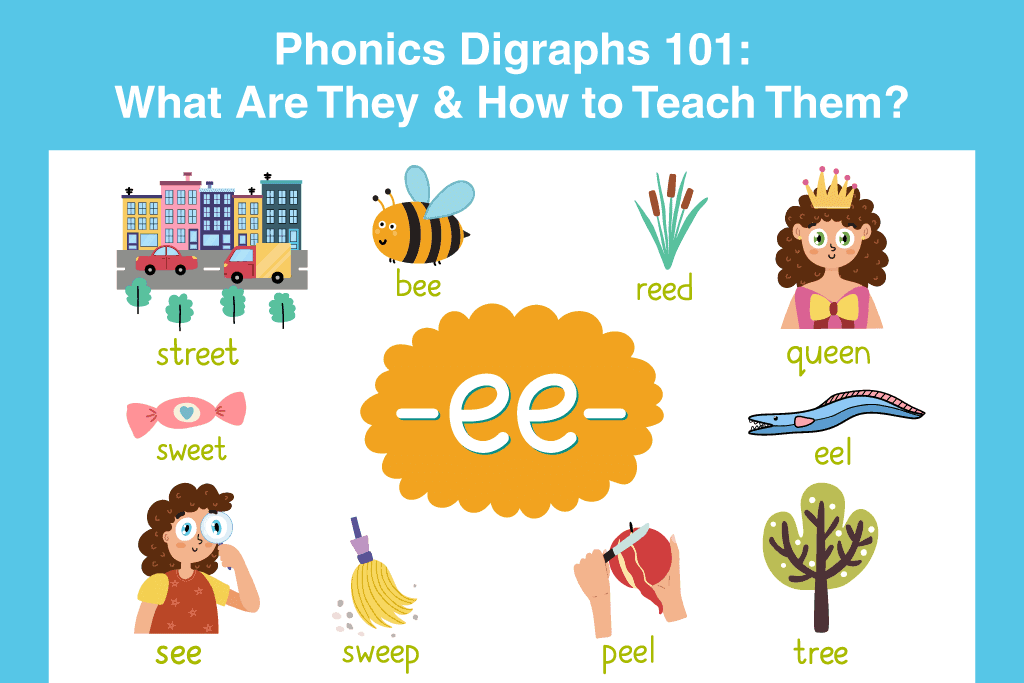Phonics Digraphs 101: What Are They & How to Teach Them?
Phonics digraphs are two letters that together represent a single sound or phoneme. Letters such as “ch,” “sh,” and “th” are perfect examples of phonics digraphs. Teaching phonics digraphs can help children learn to recognize and decode words more quickly and accurately. It can improve their reading fluency and comprehension.
In this guide, we will discuss different types of phonics digraphs and also explore their importance in language learning. We will also cover beginning consonant digraphs, vowel digraphs and other types of digraphs.
Ready to help your child master homophones? Discover effective teaching tips today!
A] Understanding Different Types Of Phonics Digraphs
The most important question here is, what are diagraphs? Teachers must learn the core meaning of digraphs before imparting the knowledge to the kids. This will make you better equipped to teach students, improving their spelling and writing skills when they join phonics classes for kids to learn these sounds.
1. Consonant Digraphs
Consonant digraphs words are pairs of consonants. When you combine these consonants, they create a new sound. This new sound differs from the individual sounds of the letters. Common examples of consonant digraph words include “ch,” “sh,” “th,” and “ck.”
Children’s ability to spell improves when they recognize and understand the sounds produced by consonant digraphs.
2. Vowel Digraphs
Vowel digraphs are pairs of vowels. They produce a single sound when you combine them. They create a sound different from the individual letters. Examples of vowel digraphs are “ai,” “ee,” “ea,” and “on.”
Teaching vowel digraphs to children is important for developing their reading and spelling skills. It also makes their phonemic awareness better.
3. Consonant & Vowel Digraphs
Combining vowel consonant digraphs in a word can create even more complex letter combinations that produce new sounds. Examples of these combinations include “igh” and “t” in the word “night,” “ee” and “p” in the word “sleep,” and “oa” and “k” in the word “oak.”
Children must master both digraphs to become more confident and skilled readers and writers.
4. Double Letter Digraphs
A double-letter digraph is a pair of identical letters representing a word’s sound. Some examples of double-letter digraphs are “ll” in the word “ball,” “ss” in the word “kiss,” and “ff” in the word “off.”
Children can expand their vocabulary and become more effective communicators by clearly understanding these digraphs.
5. Split Digraph
A split digraph, also known as a magic e or silent e, is a vowel digraph in which an “e” at the end of a word changes the pronunciation of the vowel before it. Examples of split digraphs include “a-e” in the word “cake,” “i-e” in the word “bike,” and “o-e” in the word “note.”
B] Activities For Teaching Phonics Digraphs
Here are some activities you can add to digraph lesson plans to teach digraphs to students. Phonics teacher training focuses on making teachers learn these activities.
1. Digraph Snakes And Ladders
Digraph Snakes and Ladders is a fun game to help children practise their phonics digraphs. All that you need for this activity is a digraph snakes and ladders board, which you can also create yourself.
2. Mnemonics Digraphs Flashcards
Mnemonic digraph flashcards are small cards that feature pictures and phrases that help children remember and identify different digraphs. Teachers can use these cards as a visual aid for teaching and practising digraphs. In addition, digraph activities for kindergarten such as these can make learning phonics more fun for children.
3. Digraphs Anchor Charts
Digraphs anchor charts are visual aids that provide a reference for children to remember and identify different digraphs. These charts contain pictures and words that highlight the sound and spelling of each digraph.
You can display anchor charts in the classroom or at home. These charts can help children develop their phonics skills by providing a consistent and accessible learning point.
4. I SPY Sheets
I SPY sheets are activity sheets containing pictures of objects having different digraphs. They are one of the best digraph activities for students. Children can find and circle the objects that contain the specified digraphs. I SPY sheets are a great way to reinforce phonics skills. They also help develop visual perception and attention to detail in students.
5. Fill In The Missing Sounds (Digraph)
Fill in the missing sounds is an activity in which children are presented with words that have missing digraphs. Then, the children would fill in the missing sounds. This activity helps children practise identifying and using different digraphs.
You can present this activity in various formats, such as worksheets, interactive whiteboards, or games.
6. Digraph Mystery Bag
Digraph Mystery Bag is a fun and engaging activity in which children reach into a bag and pull out an object. This object contains a specific digraph. Children then have to identify the digraph and say a word that contains that sound. This activity works for different learning levels and interests.
If you are looking for some more fun phonics activities, then you can explore these 20+ Fun Phonics Activities and Games for Early Readers.
Moving on, let’s take a look at some effective phonic digraph instructions.
C] Tips for Effective Phonics Digraphs Instruction
If you want to become a better and effective instructor for digraphs for kindergarten, here are some helpful tips.
1. Start with known sounds
Starting with known sounds is a phonics teaching strategy that involves introducing new sounds. You can do so by building on sounds that children already know. For example, if a child has already learned the “s” sound, the teacher might introduce the “sh” sound.
Do you want to explore more teaching techniques for letter sounds? Read our informative guide: 7 Tips for Teaching Letter Sounds in Kindergarten.
2. Teach one digraph at a time
Focus on one specific digraph until children have mastered its sound and spelling. For example, a teacher might spend a week or two teaching the “ch” digraph. Then, a teacher can provide examples of words that contain “ch” and have children practise reading and spelling these words.
3. Practice in context
Learning for kindergartners focuses on practising in context. It involves providing children with opportunities to practise using digraphs in real-life contexts. For example, a teacher might read a story aloud that contains words with the target digraph. He can also give children a writing prompt encouraging them to use words with the target digraph.
4. Monitor progress and adjust instruction
Regularly assess children’s understanding and skill development related to digraphs. Consider modifying instruction based on their needs. If a teacher notices that some children are struggling with a particular digraph, they might provide additional practice opportunities. They can also consider re-teaching the concept in a different way.
D] Common Challenges in Teaching Phonics Digraphs
Some common challenges that arise while teaching kindergarten digraphs include the following.
- Children may struggle to correctly pronounce digraphs, which can hinder their ability to read and spell words containing those sounds.
- They may confuse digraph sounds with other sounds that are similar, such as blends or other vowel sounds.
- Children may have difficulty blending sounds together to form words containing digraphs.
- They may become disengaged or unmotivated if they do not see the relevance of letters and sounds digraphs. It can negatively impact their progress and achievement in this area.
If you want to learn some more jolly phonics skills, you can refer to our blog: A Guide on How to Teach Phonics to Kids.
Ready to help your child master homophones? Discover effective teaching tips today!
Conclusion
Phonics digraphs are crucial for developing strong reading and writing skills in students. Which is why teachers and parents should understand the basic principle of phonics digraphs. It will make them more capable of teaching students. To summarise, some key strategies for teaching phonics digraphs include starting with known sounds, teaching one digraph at a time, and providing opportunities for practice in context.
Teachers should also monitor progress and adjust instruction as needed. They should be aware of common challenges such as mispronunciation and confusion with other sounds.
Ongoing phonics instruction is important to ensure that children develop the skills and confidence needed to become proficient readers and writers. So, you should consider reaching out to phonics experts in your area, they can help you learn more about phonics and also offer your kids the guidance they require to learn better.

Hema Dave
Stemming from the aspiration to nurture and inspire young minds, Hema started her professional journey into education 20+ years ago. She founded 'Phonic Smart' as a trained educationist, an institute committed to equipping children with phonics skills and helping parents and teachers implement them effectively. Her diverse skill sets, encompassing teaching, teacher training, and coaching allow her to contribute valuable insights to the education industry.

